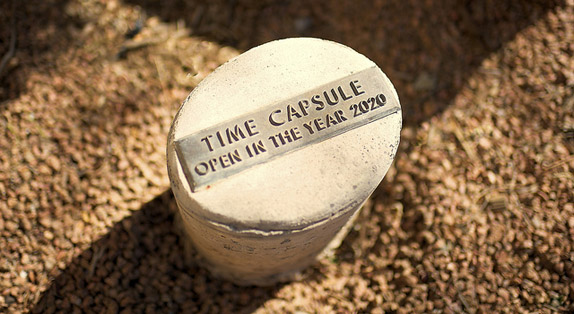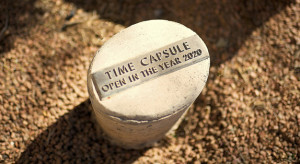 This week we begin with big mazel tov wishes to our good friends Beverly and Leon Mehl who became first time grandparents when their children Eden and Alex Mehl gave birth to a baby boy. Sholom zochor and bris information to follow. Mazel tov as well to Eden’s parents, Carol and Don Glaser of Bergenfield, New Jersey. May they all have much yiddishe nachas from the new arrival.
This week we begin with big mazel tov wishes to our good friends Beverly and Leon Mehl who became first time grandparents when their children Eden and Alex Mehl gave birth to a baby boy. Sholom zochor and bris information to follow. Mazel tov as well to Eden’s parents, Carol and Don Glaser of Bergenfield, New Jersey. May they all have much yiddishe nachas from the new arrival.
And a big mazel tov as well to our friends and shtikel machatunim, Faye and Steve Kollander (oral surgeon par excellence) upon the birth and bris this past week of their latest grandchild – Ari Gavriel- born to their children Tali and Isaac Oppenheimer. Mazel tov to both extended families.
Raboyseyee and Ladies
The First Time Capsule
From time to time we read about a time capsule filled with various items, planted into the ground or somewhere else to be opened in a hundred or five hundred or more years. Avada there is a machloikes on the web and in other writings as to who created the term ‘time capsule’ and when the first was planted. And it’s refreshing to read that not only do our rabbis disagree and argue over kimat every word in the Toirah, Mishne and Gemora, seemingly the goyim too cannot make up their minds. Said William Jarvis, whoever that was or is: the first time capsule dates back to 1876. Ober says Reb Wikipedia, a more contemporary Achroin, azoy: A time capsule is a historic cache of goods or information, usually intended as a method of communication with future people and to help future archaeologists, anthropologists or historians. Time capsules are sometimes created and buried during celebrations such as a World’s fair, a cornerstone laying for a building or at other events. Time capsules are placed with the intention that they will be opened or accessed at a future date.
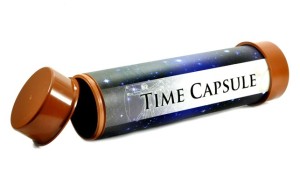 An early example of the use of a time capsule was the Detroit Century Box. The brainchild of Detroit mayor William C. Maybury, it was created on December 31, 1900, and scheduled to be opened 100 years later.
An early example of the use of a time capsule was the Detroit Century Box. The brainchild of Detroit mayor William C. Maybury, it was created on December 31, 1900, and scheduled to be opened 100 years later.
The 1939 New York World’s Fair time capsule was created by Westinghouse as part of their exhibit. It was 90 inches (2.3 metres) long, with an interior diameter of 6.5 inches (16 cm), and weighed 800 pounds (360 kg).
This first modern time capsule was followed in 1965 by a second capsule at the same site, but 10 feet to the north of the original. Both capsules are buried 50 feet below Flushing, Meadows Park, site of the Fair. Both the 1939 and 1965 Westinghouse Time Capsules are meant to be opened in 6939. More recently, in 1985, Westinghouse created a smaller, Plexiglass shell to be buried beneath the New York Marriott Marquis hotel, in the heart of New York’s theater district. However, this time capsule was never put in place.
The Crypt of Civilization (1936) at Oglethorpe University, intended to be opened in 8113, is generally regarded as the first modern time capsule, although it was not called one at the time. George Edward Pendray is responsible for coining the term “time capsule.”
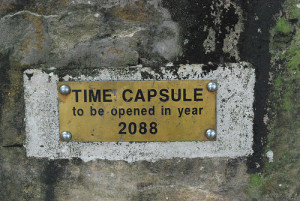 Shoin, let’s chazir (let’s review). Some say that the first time capsule was filled and buried in 1900. Kula alma loi piligu (no one would argue) that Westinghouse filled and placed a time capsule during the World’s Fair back in 1939, ober yeish oimrim (some say) that the first time capsule dates back to 1876. Which date is correct and who was the inventor of the time capsule? None of these: It was the RBSO that created the time capsule! He did?
Shoin, let’s chazir (let’s review). Some say that the first time capsule was filled and buried in 1900. Kula alma loi piligu (no one would argue) that Westinghouse filled and placed a time capsule during the World’s Fair back in 1939, ober yeish oimrim (some say) that the first time capsule dates back to 1876. Which date is correct and who was the inventor of the time capsule? None of these: It was the RBSO that created the time capsule! He did?
And why is this factoid being mentioned as an introduction to this week’s parsha of Bishalach which is most well known for kriyas Yam Suf (splitting of Reed Sea), a general mixed swim of men and women, spontaneous singing of the famous Oz Yoshir single, the first all women’s choir, a love hate relationship between the Yiddin and Moishe and between the Yiddin and the RBSO, a number of other open miracles including water from a rock and some interesting food -Mun- that fell daily for forty years? Because it so happens that it was the RBSO that mamish came up with the idea of the first ever time capsule when he instructed Moishe to place some of this magic Mun into a jar and then preserve it for later times. He did? Indeed so and soon we will read all about it. Ober, ershtens (firstly)…
Shoin, just as Parshas Boi was coming to an end, we read how the Yiddin, after a total of 430 years as guests and then slaves, were chased out of Mitzrayim. 430 years? Ober didn’t the RBSO tell Avrohom back in parshas Lech Lecho that their stay as strangers ‘in a land that does not belong to them’ would be but 400 years? He did! Yes, the number is confusing. Moreover, we also know that the challenging slavery lasted but 210 years, if that. Which number is correct? Was it 430, 400 or 210? Nu, some say that the 430 year figure used at the end of last week’s parsha, also includes stints in Mitzrayim by Avrohom and later by Yaakov. Avada you will recall that Avrohom traveled there and then lied to the Mitzrim about Soro being his wife so that they wouldn’t kill him. And efsher you recall that Soro was taken to the King’s palace for and an overnight with King Paroy -an earlier iteration- who wanted to share his kingly scepter. Avada we are taught that Soro did not give up her jewels. These mysehs seem to be included in the grand 430 year number. How long were we there? Which number is correct, ver veyst? Mistama all of them! The bottom line: If the Toirah uses three different numbers, that’s none of your business: Mistama each one represents something important. Our job is to argue and try to reconcile the numbers as best we can. Ober that for another day. Whatever the number is, since being chased out of Mitzrayim, or more accurately stated, being taken out by the RBSO, the Yiddin have been chased out of many other countries. Sadly, even today, there are many -too many- who want to chase them out of their own country. Daily we read about stabbings, bombings and other terrorist activities; our enemies want to drive us into the sea.
Ober Mitzrayim stands alone in one aspect. It’s the only country the RBSO instructed us not to resettle. Seemingly the RBSO was then, and remains today, angry with the Mitzrim and Paroy for the harsh treatment they and he meted out to the Yiddin. Grada some even question if we are allowed to visit this country for sightseeing or business purposes. Ober, avada when it comes to business, and a potential hefsid miruba (money loss), many a rabbi have issued favorable rulings. Especially so, if one proposes to give the rabbi a shtikel cut of the action.
Is it taka emes that we are forbidden to return to Mitzrayim? Where in the parsha can one find this restriction? You cannot; or maybe you can. Some say that the restriction not to return to Mitzrayim is found in three different places in the heylige Toirah and if you recall, the heylige Toirah has a total of five books. Over in Devorim (Deuteronomy 17:16) you will find these words: “You must never again return on this path (Mitzrayim).” And in our parsha mamish (Shemois 14:13), you will find these words: “..you shall never see the Egyptians anymore.” There is yet another posik in Devorim 25:65 which also speaks about not returning to Mitzrayim. Shoin, if the RBSO whose heylige Toirah does not contain extra words or even letters, went out of its way to give us three citings about not going back there, it must be a serious offense. And the sheylo (question) is azoy: Vus epes Mitzrayim? And shouldn’t that apply to parts of, or all of Europe where they didn’t just enslave the Yiddin but mamish killed millions of them? Taka a good question.
Moreover, didn’t the Rambam (Maimonides), he the codifier of so many halachic rulings, live there and wasn’t he the personal physician to the king? Seemingly he was. Other notables that lived in Mitzrayim include the Radvaz and Rabbi Betzalel Ashkenazi, he, the author of the Shita Mikubetzes, a sefer the Oisvorfer last came across in high school. Were they in violation of the Toirah? Ober our sages were mamish so clever and developed a few brilliant loopholes. We will see them below.
Nu, some of the reasons given for this prohibition include the fact that it would be an affront to the RBSO who went out of His way and performed so many miracles to extract us from Mitzrayim, to now go back. That sounds logical. Some say it’s because the people of Mitzrayim were very immoral and the RBSO warns us in the Toirah azoy: “Like the practice of the land of Egypt in which you dwelled, you shall not do.” Going back, could avada influence the Yiddin to commit immoral acts. It didn’t take much to influence the Yiddin towards immoral acts as we will be reading in the weeks and months ahead. Says the Nesivas Sholom something like this: Mitzrayim was unique. While it was the RBSO’s plan for the Yiddin to wind up there and where they would sink down to the 49th level of impurity, whatever that means, and then, after being freed, to have them rise up from -49 to a level where, 50 days later, they would be all purified and eligible to accept His Toirah in a shotgun wedding that took place on Har Sinai, Mitzrayim was a one shot deal. The RBSO efsher wanted the Yiddin to hit bottom both physically and spiritually; Mitzrayim with its avoido zoro, immorality and licentiousness, was the perfect place. So happens that the Yiddin did rise up even before being freed, if you chap, ober that was with the hot shiksa mitzri girls. Mitzrayim was the perfect place for them to sink and rise: mission accomplished. Ober following slavery, the RBSO wanted them to rise again. Not their dough of course because in His grand master plan, He wanted to give them Pesach and ways to make a living and also to spend a hundred million a year marking the Yom Tov. And taka while there, the Yiddin taka were not well behaved. They stopped performing circumcisions, they worshipped idols and seemingly did other despicable acts. So many that the malochim (angels) argued they should efsher drown in the sea. It appears that this was all part of the plan. In order to become His Chosen People, they needed to prove their devotion. First they needed to be tempted by the lowest of the low in all other areas. Mitzrayim was the perfect host country; they did their part to perfection. Ober, once the RBSO realized that the Yiddin took the bait, participated in all Mitzrayim had to offer, and that they were about to sink to level -50, one they could not recover from, He changed His mind and aborted the plan. He had mamish rachmunis and commuted the 400 year sentence to 210. Shoin, just like that one year later, they were free and on their way into the Midbar where a new series of tests would challenge their devotion. Grada they didn’t fare too well there either and some say, they tested the RBSO as many as ten times prior to Har Sinai. Why He stuck with them, ver veyst?
In any event, though the heylige Toirah specifically tells us not to return to Mitzrayim, our sages, in their brilliance decided maybe we can. There are efsher work-arounds to the prohibition. Ershtens, the prohibition applies only to returning to Mitzrayim from Israel. Say the Radvaz: the prohibition of returning to Mitzrayim pertains only to those that want to live there. Ober, if one is but passing through as a tourist, to sightsee, to chap some business – efsher some fine Egyptian cotton for some linen or a shirt, or for efsher something else fine, then it’s quite ok. Others say, the restriction applies to a return using the same exact route the Yiddin took when they left. Mamish ingenious. Some say the restriction was only in effect when the people of Mitzrayim were particularly immoral. Avada in our times, there are fine upstanding citizens. Of course.
 Shoin, everyone is avada familiar with the phrase ‘Manna From Heaven’ and it always connotes something unusually good. A windfall or some unexpected gain. And everyone that has studied the heylige Toirah and even those who did not, avada know that it was the RBSO who created Mannah and then sent it down to the Yiddin who feasted on it for 40 years.
Shoin, everyone is avada familiar with the phrase ‘Manna From Heaven’ and it always connotes something unusually good. A windfall or some unexpected gain. And everyone that has studied the heylige Toirah and even those who did not, avada know that it was the RBSO who created Mannah and then sent it down to the Yiddin who feasted on it for 40 years.
Shoin, we previously covered the Mun ober this year we should take a look at a very interesting posik wherein the RBSO tells Moshe to instruct Aharoin to collect some Mun, place it into a jar and then to preserve it in a ‘time capsule’ of sorts for later generations. Lommer lernin, ober before we do, let’s recall that the Mun had very special magical characteristics. Our sages teach us (Yomah 75a) azoy: the Mun could taste like anything a person consuming it wanted it to taste like with five exceptions. The exceptions were cucumber, melon, leek onion and garlic. Shoin! Vus epes these five? Says Rashi who of course knew, azoy: these five food items can be harmful to pregnant and nursing women and therefore were removed from the very exhaustive list of food choices one could conjure up and enjoy. Nu, efsher you’re klerring azoy: if the RBSO was already performing magic -a neys min hashomayim mamish (miracle)- and sending Mun daily which could be eaten as is, or cooked, baked and even fried, and could also taste like anything a person wanted or imagined, why wouldn’t He or didn’t He just program the Mun to taste like everything else but those five items? Or, efsher better, why didn’t He program the Mun so that it wouldn’t affect pregnant or nursing women? He is the RBSO! Ver veyst? One medrish will tell us that because the Mun could efsher have a deleterious effect on pregnant and nursing women, the RBSO in His magnificence and sensitivity did not want them feeling bad that others were enjoying His perfect food which they couldn’t. Therefore, He made sure not to exclude them and instead made sure that the Mun could be enjoyed by all. Was that the case, ver veyst.
Nu, some wisenheimer wanted to know more details of the magic mun. How did it work? How could Mun taste like a steak to one person and to ice cream or pizza to another? Did those in the mood of a particular item, need to just visualize the item before the Mun took on its taste? Or, did the person need to verbalize the particular craving? In other words: did the person need to look at the Mun and state: I want you to taste like pizza? Nu believe it or not, this question was mamish discussed and like everything else, also argued over. Says the Moishav Zikeineim azoy: one taka needed to verbalize the particular taste he wanted to enjoy, much as one would order a particular food at a restaurant.
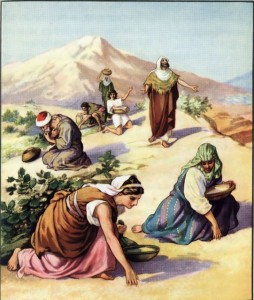
In any event, no matter what it looked or tasted like and no matter how much and when it came or how it was delivered, what we know is that Moishe was instructed to save some. Says the heylige Toirah (Shemois 16:32): Moishe said, ‘this is the thing that the RBSO has commanded: a full measure of it shall be a safekeeping for your generations, so that they will see the food with which I fed you in the wilderness when I took you out of Mitzrayim.’ And there you have it Raboyseyee, proof positive that it was taka the RBSO that created the time capsule.
Why would the RBSO want to preserve Mun? Says the Michilta so gishmak azoy: the time capsuled Mun was to make an appearance some 1000 years later. The novee Yirmiyohu (Prophet Jeremiah) would dig up the time capsule and lo and behold, the Mun was still there, seemingly well preserved. And that was taka a miracle because the heylige Toirah told us that Mun not eaten on the very day it was collected (except for shabbis), went bad. Ober this time capsuled Mun was still seemingly edible and Yirmiyohu used it to chastise the Yiddin. Yirmiyohu was admonishing the Yiddin to learn more Toirah. They answered azoy: how will me make a living if we dedicate ourselves to study? How and what will we eat? Ober Yirmiyohu wasn’t placated; he took out the jar of Mun and said azoy: The RBSO can always provide as He did for the generation of Yiddin in the Midbar. In other words: spend your time learning the heylige Toirah; all else will fall into place because the RBSO will have your back. Gishmak. Avada in our times, we don’t have Yirmiyohu nor that jar of Mun to provide those assurances. Shoin, off to work we go. Seemingly, we’re still being punished for the sin of Odom Horishoin (Adam).
And what are the lessons of the Mun. Why Mun? Could it be that the RBSO used the Mun to teach the Yiddin a few life lessons? Let’s recall that when it came to Mun collection, each person was instructed to collect only the amount needed per person of the household. After being slaves and mistama hoarding whatever they could find or did receive, here they were, Mun was aplenty and strewn all over the fields. Yet, they needed to learn how to share and look out for their fellow Jew. Seemingly, for the most part, they did. And one more lesson: it was through Mun, that the Yiddin were introduced to the heylige Shabbis. Shabbis? What shabbis? Wasn’t shabbis first commanded in the Aseres Hadibrois (Ten Commandments)? Yes and no! Last we heard about shabbis was back in parshas Bereishis. At that time we heard how the RBSO rested on the seventh day, ober nothing about shabbis restrictions for the masses. We knew mamish nothing about shabbis or its observance. And let’s recall that the big ceremony on the little mountain was still some weeks away.
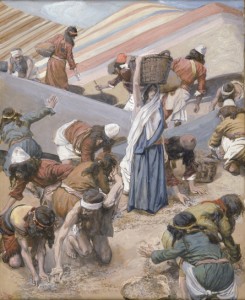 Ober based on the text where the Yiddin are instructed to collect double portions on Friday since none will fall and none will be found on the shabbis, our rabbis will teach us that it was taka here at Mara – at this very location- where the Yiddin were encamped, that He chose to teach them about shabbis. Mun was the instrument.
Ober based on the text where the Yiddin are instructed to collect double portions on Friday since none will fall and none will be found on the shabbis, our rabbis will teach us that it was taka here at Mara – at this very location- where the Yiddin were encamped, that He chose to teach them about shabbis. Mun was the instrument.
In the end, the RBSO’s master plan is suddenly in focus and illuminated. Could it be that the RBSO arranged it so that the Yiddin would be enslaved in Mitzrayim in order that they leave with enormous wealth? Of course! The RBSO did promise them wealth. He always delivers. Mitzrayim had the wealth. Yoseif helped Mitzrayim become the wealthiest nation on earth. And to ensure wealth, the RBSO also ordered that the Yiddin borrow (permanently) all sorts of gold, silver and other trinkets on their way out. And what they couldn’t schlep because the women were also carrying their drums and other instruments which they spontaneously pulled out and struck up the band following the sea crossing, they found when the sea spit up all the wealth that Paroy’s horses and chariots were carrying when they gave chase to the Yiddin. Why Paroy adorned his chariots with yet more gold and silver in order to chase down his former slaves, ver veyst. Ober we need to remember: it was all part of the RBSO’s plan. Perhaps he was going to bribe them, ver veyst. And because the Yiddin were laden down with so much gold and wealth, of course they had no time to bake bread for their journey. Hence, the RBSO gave them the great holiday of Pesach and all its trimmings. We talk about this event yearly and all year round. Grada we begin as Pesach lets out by asking azoy: where are we going for Pesach next year? Should we come back to this hotel and program? Likely not! We could do better; we deserve better. And to pay for the hand baked shmura matzo and the Yom Tov trimmings, the Yiddin mistama sold some of their gold and other wealth. Is the RBSO great or what?
And we close with this question: vus epes Mitzrayim (why did the RBSO select Egypt) as the land where the Yiddin would be enslaved and be freed from with great wealth)? We already discussed a few reasons above. We can add azoy: Mitzrayim was close enough to Israel, a three day journey at best had it been bashert that they go straight. Ober the RBSO had other plans; He was still nation building and He did this by having His people spend 40 years in the midbar where very slowly they, salves for 210 years, would learn how to behave like real people. It took all 40 years and many failed the test and died along the way.
A gittin Shabbis –
The Oisvorfer Ruv
Yitz Grossman
